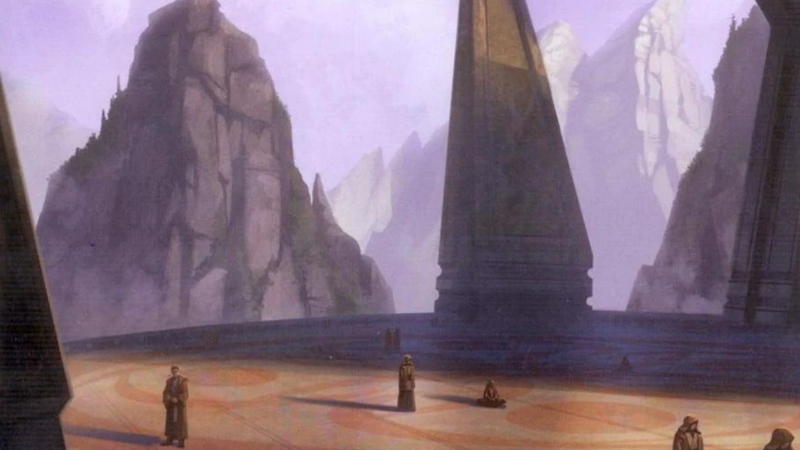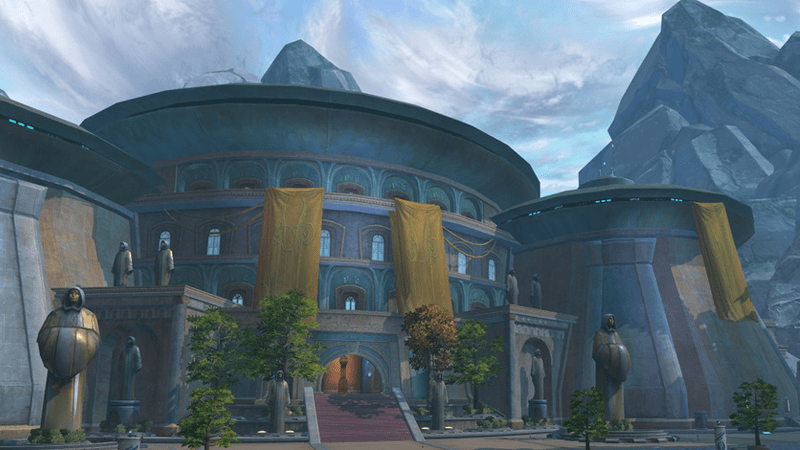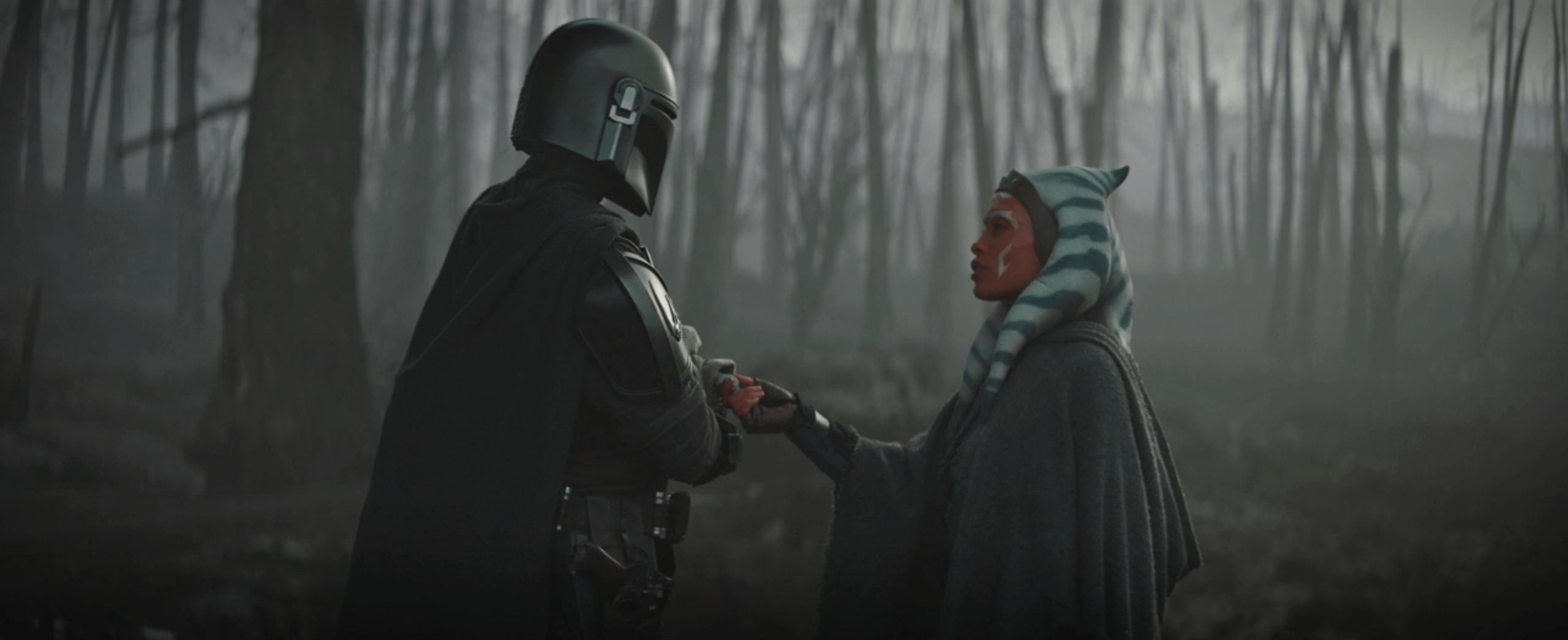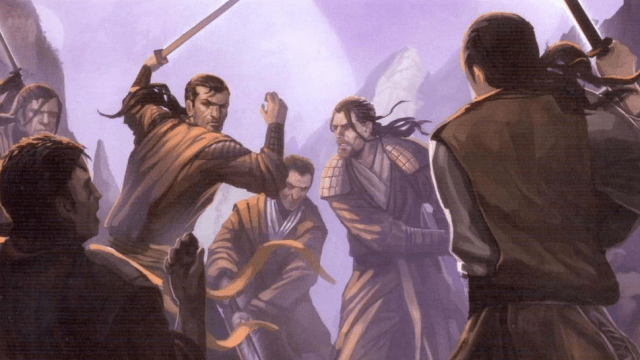Din Djarin’s quest on The Mandalorian has evolved. In finding Ahsoka Tano unwilling to train his ward, he has been sent on a new path with a new understanding, both of the child he cares for and that child’s role in his own destiny. It awaits on a planet discussed in whispers in the Disney era of the Star Wars canon, but one that has a large and complex history: Tython.
The Mandalorian’s 13th chapter, “The Jedi,” is not the first time Tython has been mentioned in this period of the franchise’s rebooted canon. Marked by maps and mentioned in roleplaying game sourcebooks, its most prominent references come in the sacred Jedi texts Rey and Luke pored over in The Last Jedi and The Rise of Skywalker, and it even made an appearance in Marvel’s Doctor Aphra series. The planet is still a mystery now, one that might only find a fragment of itself solved when or if our Mandalorian hero and Baby Yoda/Grogu ever make it there. All we really know is that some believe it’s one of the oldest sacred grounds of the Jedi Order in history.
One of.
In Disney’s canon, locations like Ahch-To and other ancient ruins have superseded what was once Tython’s defining feature when it was first introduced in the pages of Drew Karpyshyn’s novel Darth Bane: Rule of Two in 2007. Tython was the ancestral seat of the Jedi Order, its homeworld, and the guiding light of its Knights and Masters from its grand temple. But its replacements, and even its place in the current canon as part of the earliest days of the Order’s origins, have yet to really touch on another part of Tython’s fascinating presence in the old Star Wars universe, one that could have similarly fascinating implications if The Mandalorian ever dares to tap into it.
Tython wasn’t just the birthplace of the Jedi Order.
It was the birthplace of its predecessor: a gathering of Force-sensitive beings that existed in balance, beyond the diametrically opposed ideas of Dark and Light.

Tens of thousands of years before the Jedi Order existed, Tython and its twin moons (Ashla and Bogan) were a nexus of power resonances within the Force. Home to mythic creatures and verdant biomes, its connection to the Living Force was reflected in its environment of overwhelming, abundant life: life that could become violently thrown out of balance by disruptions to its extreme sensitivity to the Force. Over millennia, many of the galaxy’s oldest spacefaring races laid their mark on the world, from the ancient Gree to Dathomir’s Kwa, but even they were not the first to build a civilisation there, stories of ancient races lost to time.
It wouldn’t be a single species that gave rise to Tython’s status as a beacon of Force religiosity, however. Thousands upon thousands of years after the Gree and Kwa had abandoned Tython — approximately 36,000 years before the events of the Skywalker Saga — a migration of Force-sensitive beings from myriad species took to the stars aboard a fleet of vessels known as the Tho Yor. Composed of cultists like the ancient Dai Bendu and other Force-adjacent religions, these immigrants and the pyramidic Tho Yor themselves resonated with Tython’s deep connections to the Force. Seeing it as their destiny to learn the ways of the Force and better understand Tython’s connections to it, the Tho Yor migrant ships made landfall across its continents, its passengers constructing temples and cities around them. They were no longer a disparate group, but the foundation of the Tythan people.

With the Tythans unifying as a civilisation, so did its tenets in the Force. A unified religion to study and understand ways to wield it, beyond just connection and sensitivity, began with the establishment of the Je’daii and the building of temples around each of the nine Tho Yor vessels across Tython’s surface. The Je’daii took their environment not just as destiny but as a guiding principle, learning one of Tython’s oldest secrets in the process.
Tython’s sensitivity to the Force was such that even the very presence of beings who were strong in it could cause cataclysmic, devastating environmental events known as Force Storms, requiring a delicate harmony between Tython and the people who now called it home. Out of this realisation, two Je’daii schools of thought emerged, named for the world’s twin moons: Ashla, representing what we could come to know as the light, and Bogan, reflecting its dark shadow. The balance of both moons, born of Tython, kept the planet’s ecosystem stable, and so a Je’daii could not be solely powerful in one layer of the Force’s power. They strived to live a life of balance, experiencing all of the Force’s mysteries to try and keep Tython’s environment at peace.
As millennia passed, and non-Force sensitive Tythans emigrated from their homeworld — acknowledging a growing realisation that those unable to reach out in the Force were endangered by the planet’s enduring volatility — the Je’daii became a beacon for those seeking an understanding of their connection to this power across the Deep Core worlds of the galaxy and beyond. For 10,000 years, the Je’daii trained beings from all over the galaxy in their ways, defended Tython and its home system from outside attack, and lived lives of harmony, until…well, discourse shattered their order. Following a conflict with the Rakatan Empire that saw the Je’daii take to arms, wielding swords they had learned to imbue with the energies of the Force itself, the schools of Ashla and Bogan began advocating for finding strength, not in balance, but a singular aspect. Idealogical divide pushed them further and further apart and the Ashla split off from the Bogan entirely, renaming themselves as simply the Jedi.

But when one of the Jedi betrayed their new faction to join the Bogan Je’daii, a massive war broke out. Between the conflict and the weaponisation of the Tho Yor as machine vessels for vast amounts of Force energy, the downfall of the Je’daii — known as the Force War, ending in the Jedi quelling the Bogan forces — laid the environmental groundwork for a cataclysmic Force storm that ravaged Tython’s surface. Surviving Bogan Je’daii left their homeworld for the outer rim, while the Jedi, discovering that their powers were not limited to Tython itself, abandoned the world to Force storms, hunting down Bogan dissidents aboard fleets of generation ships before eventually settling on the planet of Ossus as the new seat of the Jedi Order nearly eight centuries after the Force War.
Tens of thousands of years — and the rise of the Galactic Republic within the Core Worlds — would pass before the Jedi returned to their ancestral home. Over time, the Jedi relocated from Ossus to Coruscant, deepening their ties with the nascent Republic, which had cut off hyperspace lanes and banned travel to Tython given the lingering effects of its ancient cataclysm. Although the Jedi of the Old Republic would resettle and build temples there once more, Tython would ultimately fall to cataclysm in the millennia afterwards time and time again, as cold wars between the Jedi, Republic, and now burgeoning Sith Empire became hot across the galaxy. Thrown out of balance seemingly in perpetuity, Tython’s surface was all but devastated by storms and natural disasters. Although Sith and Jedi alike would attempt to re-establish academies there over the Republic’s long history, the world slid into obscurity long before the Republic’s own twilight, taking the origins of the Jedi and those that came before its order with it.

Tython’s history, woven throughout old EU classics like Rule of Two, John Ostrander and Jan Duursema’s Dark Horse comic series Dawn of the Jedi, and games like Bioware’s The Old Republic MMO, presents a picture of a world so much richer and deeper than simply being the long-forgotten resting place of the dusty ruins of some old Jedi temple. If The Mandalorian is willing — and, given that Clone Wars and Rebels’ Dave Filoni is a fundamental architect, it would be an easy bet to at least hope it is — it is a history that the series could tap into.
Why does it have to be a Jedi that reaches out to Grogu, if anyone does? Why must this child throw his lot in with an Order that already failed him? If Grogu finds his own path, the potential for it to be outside of the constraints of the Jedi as a code, as an organisational structure, is there in Tython’s vast history. All he has to do is hope that the show’s creators reach out and sense it, too
You can catch The Mandalorian streaming on Disney+.
